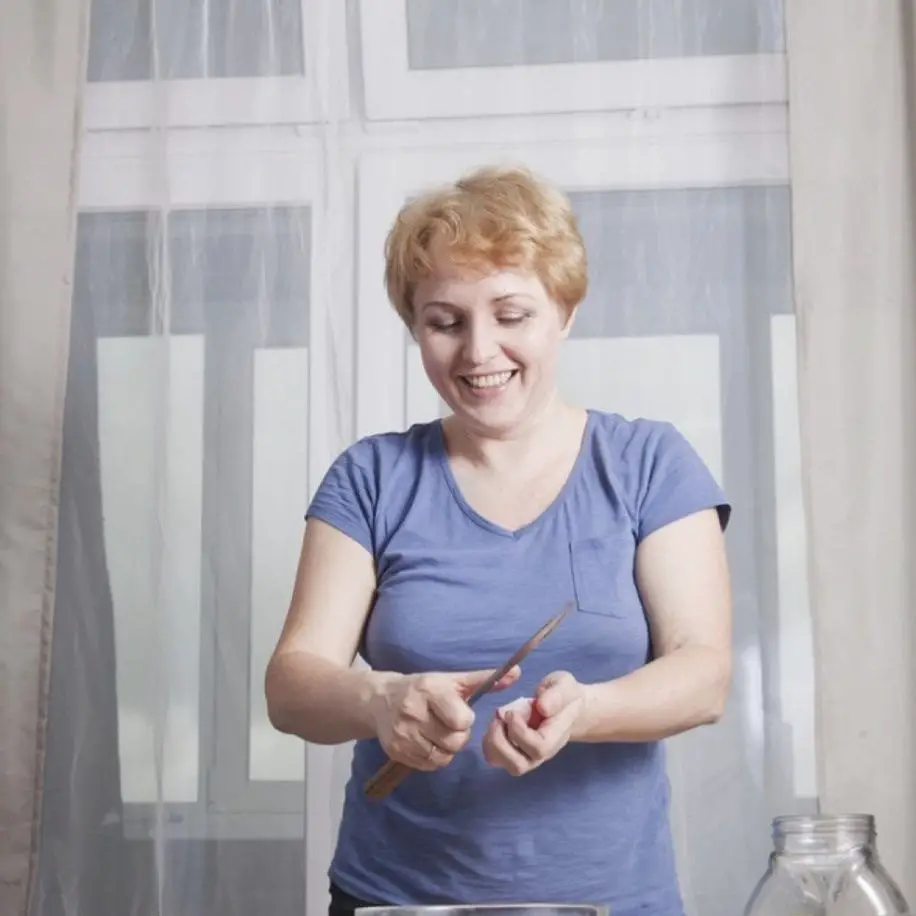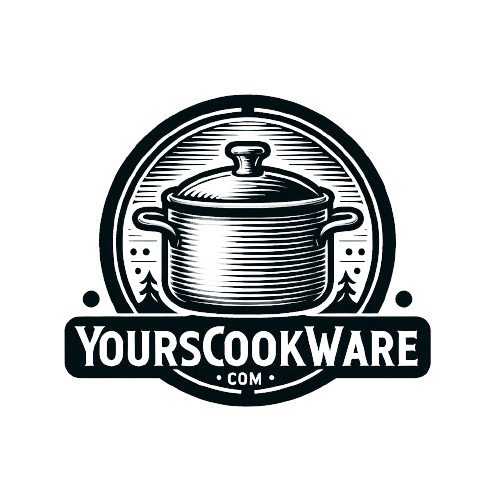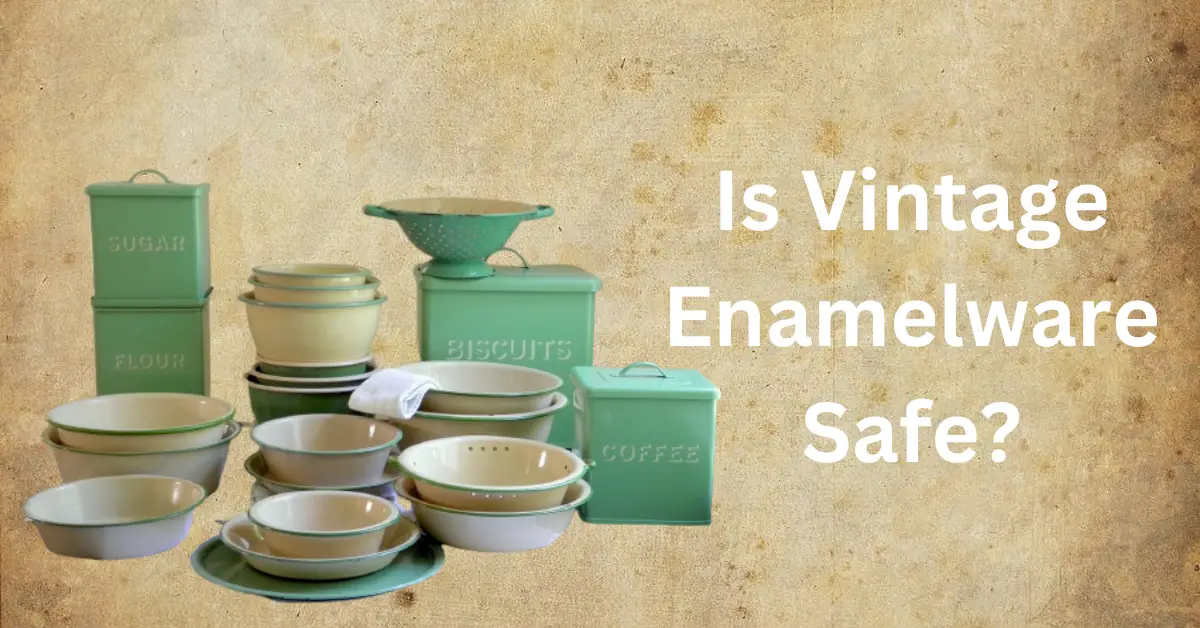Is Vintage Enamelware Safe To Use? No, Vintage Enamelware isn’t safe. Vintage Enamelware may contain lead, cadmium, or other heavy metals that could harm your health.
Vintage enamel can pose a severe health risk. This is because it can contain toxic levels of heavy metals, like lead and cadmium. (Chelsea)
If you want to be safe, avoid using vintage Enamelware.
What is vintage enamel?
Vintage Enamelware is kitchenware made of metal coated with a thin enamel layer. Enamelware was first introduced in the 18th century and became popular in the 19th and early 20th centuries. It was valued for its durability, bright colors, and smooth finish. Today, vintage Enamelware is a collector’s item and is often used for decoration.
What is vintage Enamelware made of?
Vintage Enamelware is made of iron, steel, or aluminum, coated with enamel. The enamel coating makes it smooth, durable, and easy to clean – perfect for use in the kitchen! The downside of Enamelware is that it is easy to chip and break.
The enamel coating is usually colored, often with a white or cream base, and decorated with designs and patterns in various colors. Enamelware was very popular in the early 1900s, and many still collect it today.

How to identify vintage Enamelware?
There are a few things you can look for when trying to identify vintage Enamelware. Here are some helpful tips:
Age: Vintage Enamelware is usually several decades old, so look for signs of wear and tear, such as rust, chipping, or fading. Check for any dents, scratches, or discoloration on the metal beneath the enamel. These imperfections can give you an idea of the item’s age and use. The enamel may not be vintage if it is still in good condition.
Color: Vintage Enamelware often has a unique color palette, such as pastel blues, greens, and pinks. They also have a smooth, glossy surface.
Design: Vintage Enamelware often has old design than newer pieces. For example, the 1930s and 1940s saw a lot of art deco designs, while the 1950s saw a rise in floral and abstract patterns.
Markings: Some vintage enamelware may have a signature by the artist. Many vintage enamelware pieces are signed by the artist who created them.
Weight: Vintage Enamelware is often heavier than modern Enamelware, as it was made with thicker metal.
Are old enamel bowls safe?
If the bowl is cracked or chipped, it’s unsafe to use. Because old enamel bowls can have toxic levels of heavy metals, like lead and cadmium, which can cause serious health problems, if you’re using an old enamel bowl, ensure it’s in good condition.
Is 1970s enamelware safe to use?
No, Enamelware from the 1970s likely contains lead, which can leach into food and cause health problems. Alternatively, consider replacing it with newer, safer Enamelware that meets current safety standards.

Is scratched enamel cookware safe?
If you have new or modern design (not vintage) enamel cookware and the scratches are just on the surface, it is still safe to use. However, if the scratches are deep, it is no longer safe to use, and you should buy a new pot or pan.
What can I do with vintage Enamelware?
There are a lot of things you can do with vintage Enamelware. Here are some ideas:
Planters: Use enamelware pots or bowls to plant herbs, succulents, or small flowers.
Utensil holders: Use enamelware pitchers, mugs, or jars to hold cooking utensils on your countertop.
Candle holders: Use enamelware cups or bowls to create unique candle holders.
Jewelry organizers: Use enamelware plates or trays to hold and display your jewelry.
Soap dishes: Use enamelware plates or bowls as rustic soap dishes.
Wall art: Hang vintage enamelware plates or trays on your walls for a unique and colorful display.
Bird feeders: Use enamelware cups or bowls to create bird feeders for your backyard.
Fruit bowls: Use enamelware to display fresh fruit on your kitchen counter.
Table centerpieces: Fill enamelware pitchers or bowls with flowers or fruit for a unique table centerpiece.

How to date Enamelware
Enamelware can be difficult to date accurately because it has been produced for over a century, and many pieces have similar designs. But I found some ways to determine the age of Enamelware:
- Many parts of vintage Enamelware have markings on the bottom or back that can help identify the manufacturer and date. These markings can include names, logos, and patent numbers.
- Vintage Enamelware was often produced in specific colors during certain periods. For example, much Enamelware from the early 1900s is white or cream-colored.
- The style of Enamelware can also help date it. Older pieces have simpler designs, while newer pieces may have more elaborate patterns or decorations.
How do you clean vintage Enamelware?
The best way to clean vintage Enamelware is to:
Use a gentle detergent and warm water.
Make sure that the piece is rinsed thoroughly with warm water.
Mix a small amount of detergent in a bowl of warm water.
Use a soft sponge or cloth to apply the soapy water to the Enamelware, being careful not to scrub too hard.
Finally, rinse the piece with clean water and dry it with a soft towel.
Can you cook in vintage enamel pots?
No, Vintage enamel pots may not have been made with modern safety standards in mind. So, it’s better to stay away from cooking in these pots. Instead, focus on using pots designed with current safety standards in mind. This way, you can avoid accidents or injuries from using outdated pots.

I am Linda. A housewife and a writer, and also the founder of this site. I love cooking and collecting cookware sets. I’ve been blogging since 2020, and in this blog, you can find cookware-related problems and solutions, cookware reviews, safe cookware sets, and more.
I have put a lot of effort into gathering here the experience and knowledge that I have, and I want to help every reader.

